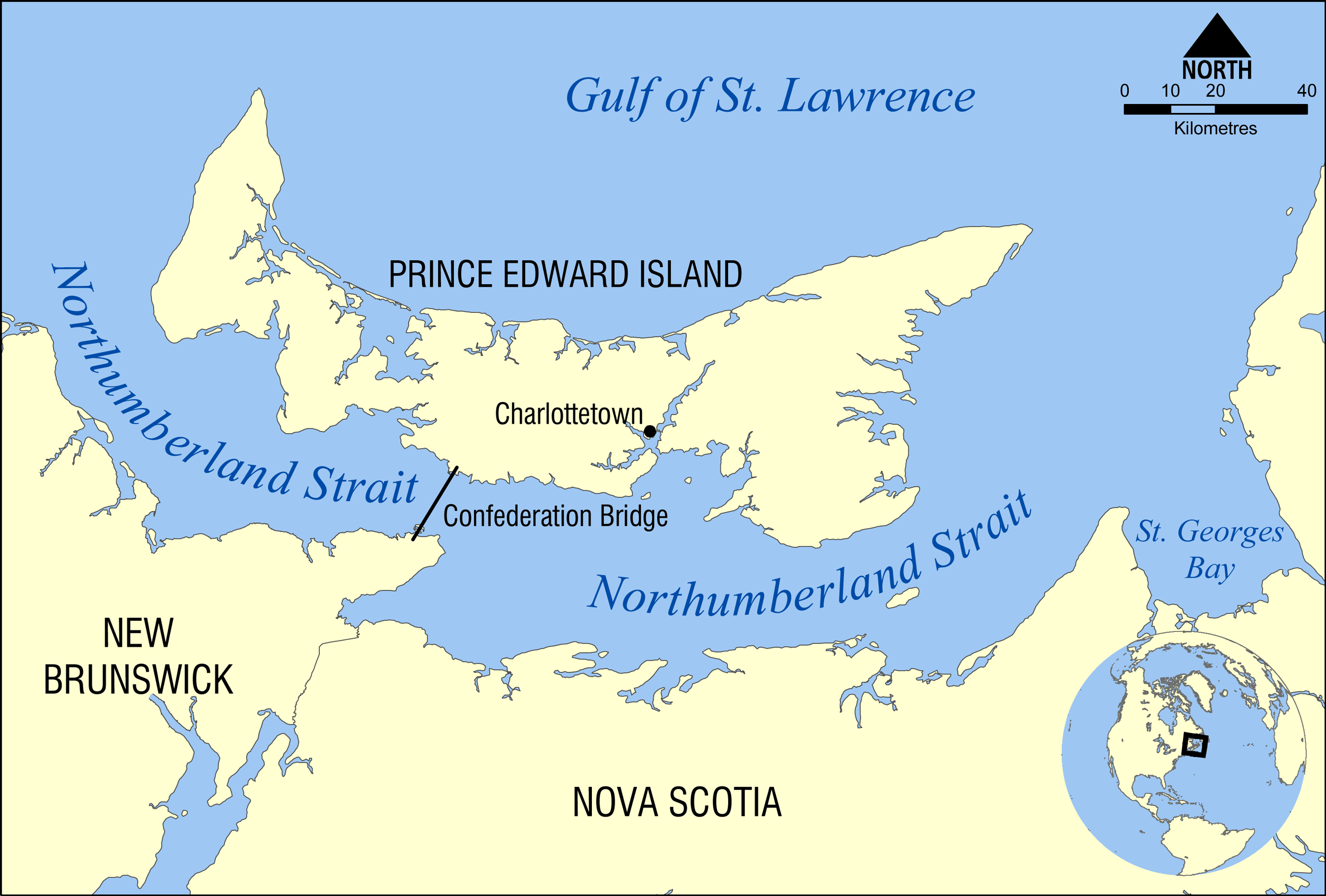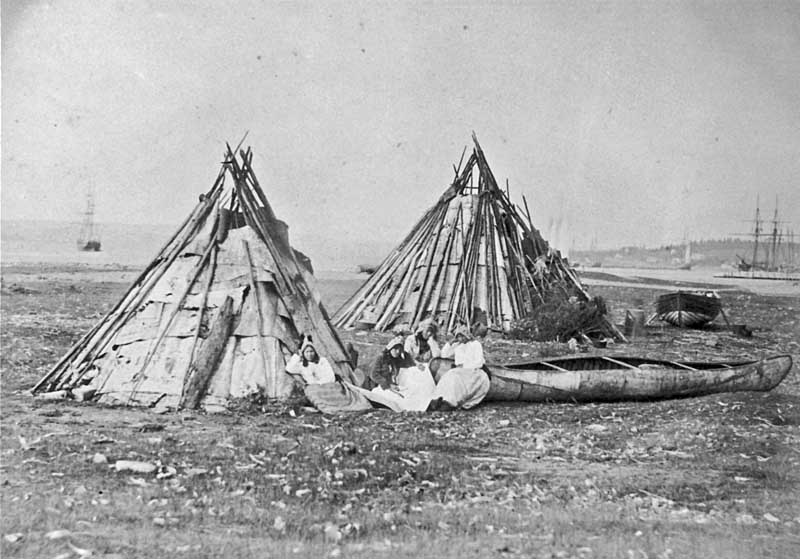|
Pugwash, Nova Scotia
Pugwash is an incorporated village in Cumberland County, Nova Scotia, Canada, located on the Northumberland Strait at the mouth of the Pugwash River. It had a population of 746 as of the 2021 census. The name Pugwash is derived from the Mi'kmaq word, Pakwesk (also written as Pagwĕsk) meaning "a shoal", in reference to a reef near the mouth of the harbour. The village is home to fishing, salt mining, and small-scale manufacturing, and tourism. Pugwash sits atop a salt deposit measuring thick and is home to the largest underground salt mine in Atlantic Canada, with shipments from its port, as well as by rail from a facility at Oxford Junction. History The end of glaciation began 13,500 years ago and ended with the region becoming largely ice-free 11,000 years ago. The earliest evidence of Palaeo-Indian settlement in the region follows rapidly after deglaciation. The Pugwash area is part of the Mi’kma’ki territory of the Mi’kmaq, who have inhabited their traditional ... [...More Info...] [...Related Items...] OR: [Wikipedia] [Google] [Baidu] |
Villages Of Nova Scotia
A village is a type of community in the Canadian Province of Nova Scotia that has a commission established under the ''Municipal Government Act'' for the purpose of providing municipal services to a defined area within a larger county or district municipality. Nova Scotia has 21 villages. According to available population data, Nova Scotia's largest and smallest villages are Bible Hill and River Hebert with populations of 8,913 and 1,296 respectively. List Former villages Nova Scotia has recognized at least four other villages in its history. The villages of Brooklyn and Milton dissolved on April 1, 1996 upon the amalgamation of the Municipality of the County of Queens with the Town of Liverpool to form the Region of Queens Municipality. On the same date, the villages of Uplands Park and Waverley dissolved upon the amalgamation of the Municipality of the County of Halifax with the cities of Dartmouth and Halifax and the Town of Bedford to form the Ha ... [...More Info...] [...Related Items...] OR: [Wikipedia] [Google] [Baidu] |
Northumberland Strait
The Northumberland Strait (French: ''détroit de Northumberland'') is a strait in the southern part of the Gulf of Saint Lawrence in eastern Canada. The strait is formed by Prince Edward Island and the gulf's eastern, southern, and western shores. Boundaries The western boundary of the strait is delineated by a line running between North Cape, Prince Edward Island and Point Escuminac, New Brunswick while the eastern boundary is delineated by a line running between East Point, Prince Edward Island and Inverness, Nova Scotia. Hydrography The Northumberland Strait varies in depth between 17 and 65 metres, with the deepest waters at either end. The tidal patterns are complex; the eastern end has the usual two tides per day, with a tidal range of 1.2 to 1.8 metres, while the western end effectively has only one tide per day. The strait's shallow depths lend to warm water temperatures in summer months, with some areas reaching 25° C, or 77° F. Consequently, the strait is repo ... [...More Info...] [...Related Items...] OR: [Wikipedia] [Google] [Baidu] |
Expulsion Of The Acadians
The Expulsion of the Acadians, also known as the Great Upheaval, the Great Expulsion, the Great Deportation, and the Deportation of the Acadians (french: Le Grand Dérangement or ), was the forced removal, by the British, of the Acadian people from parts of a Canadian-American region historically known as ''Acadia'', between 1755–1764. The area included the present-day Canadian Maritime provinces of Nova Scotia, New Brunswick, and Prince Edward Island, and the present-day U.S. state of Maine. The Expulsion, which caused the deaths of thousands of people, occurred during the French and Indian War (the North American theatre of the Seven Years' War) and was part of the British military campaign against New France. The British first deported Acadians to the Thirteen Colonies, and after 1758, transported additional Acadians to Britain and France. In all, of the 14,100 Acadians in the region, approximately 11,500 were deported, at least 5,000 Acadians died of disease, starva ... [...More Info...] [...Related Items...] OR: [Wikipedia] [Google] [Baidu] |
Acadians
The Acadians (french: Acadiens , ) are an ethnic group descended from the French who settled in the New France colony of Acadia during the 17th and 18th centuries. Most Acadians live in the region of Acadia, as it is the region where the descendants of a few Acadians who escaped the Expulsion of the Acadians (aka The Great Upheaval / ''Le Grand Dérangement'') re-settled. Most Acadians in Canada continue to live in majority French-speaking communities, notably those in New Brunswick where Acadians and Francophones are granted autonomy in areas such as education and health. Acadia was one of the 5 regions of New France. Acadia was located in what is now Eastern Canada's Maritime provinces, as well as parts of Quebec and present-day Maine to the Kennebec River. It was ethnically, geographically and administratively different from the other French colonies and the French colony of Canada (modern-day Quebec). As a result, the Acadians developed a distinct history and culture. ... [...More Info...] [...Related Items...] OR: [Wikipedia] [Google] [Baidu] |
Miꞌkmaq
The Mi'kmaq (also ''Mi'gmaq'', ''Lnu'', ''Miꞌkmaw'' or ''Miꞌgmaw''; ; ) are a First Nations people of the Northeastern Woodlands, indigenous to the areas of Canada's Atlantic Provinces and the Gaspé Peninsula of Quebec as well as the northeastern region of Maine. The traditional national territory of the Mi'kmaq is named Miꞌkmaꞌki (or Miꞌgmaꞌgi). There are 170,000 Mi'kmaq people in the region, (including 18,044 members in the recently formed Qalipu First Nation in Newfoundland.) Nearly 11,000 members speak Miꞌkmaq, an Eastern Algonquian language. Once written in Miꞌkmaw hieroglyphic writing, it is now written using most letters of the Latin alphabet. The Mi'kmaq, Maliseet, and Pasamaquoddy nations signed a series of treaties known as the Covenant Chain of Peace and Friendship Treaties with the British Crown throughout the eighteenth century; the first was signed in 1725, and the last in 1779. The Miꞌkmaq maintain that they did not cede or give up their ... [...More Info...] [...Related Items...] OR: [Wikipedia] [Google] [Baidu] |
Miꞌkmaꞌki
Miꞌkmaꞌki or Miꞌgmaꞌgi is composed of the traditional and current territories, or country, of the Miꞌkmaq people, in what is now Nova Scotia, Canada. It is shared by an inter-Nation forum among Miꞌkmaq First Nations and is divided into seven geographical and traditional districts. Today ''Taqamkuk'' is separately represented as an eighth district. Miꞌkmaꞌki is one of the confederate nations within the Wabanaki. History Each district was autonomous, headed by a '' Sagamaw''. He would meet with Wampum readers and knowledge keepers called ''turkey keeper's'', a women's council, and the ''Kji Sagamaw'', or Grand Chief, to form the ''Santeꞌ' or ''Miꞌkmawey Mawioꞌmi (Grand Council). The seat of the Santeꞌ Mawioꞌmi is at Mniku in Unamaꞌkik. It still functions as the capital today in the Potlotek reserve. Following European contact, Miꞌkmaꞌki was colonized by the French and British in modern Nova Scotia, who made competing claims for the land. S ... [...More Info...] [...Related Items...] OR: [Wikipedia] [Google] [Baidu] |
Oxford Junction, Nova Scotia
Oxford Junction is a Canadian rural community in Cumberland County, Nova Scotia, which lies approximately 5 kilometers to the southwest of the town of Oxford. Oxford Junction received its name from its railway heritage. The Intercolonial Railway of Canada built its Halifax-Montreal mainline through the area in the early 1870s. In the late 1880s, the ICR built a line nicknamed the "Short Line" along the Northumberland Strait The Northumberland Strait (French: ''détroit de Northumberland'') is a strait in the southern part of the Gulf of Saint Lawrence in eastern Canada. The strait is formed by Prince Edward Island and the gulf's eastern, southern, and western sh ... shore of Nova Scotia from Oxford Junction to Stellarton but it was abandoned in 1986. Many of the homes built in the early 1900s still stand to this day, and several are still in use. References * Communities in Cumberland County, Nova Scotia {{CumberlandNS-geo-stub ... [...More Info...] [...Related Items...] OR: [Wikipedia] [Google] [Baidu] |
Atlantic Canada
Atlantic Canada, also called the Atlantic provinces (french: provinces de l'Atlantique), is the region of Eastern Canada comprising the provinces located on the Atlantic coast, excluding Quebec. The four provinces are New Brunswick, Newfoundland and Labrador, Nova Scotia, and Prince Edward Island. As of 2021, the landmass of the four Atlantic provinces was approximately 488,000 km2, and had a population of over 2.4 million people. The provinces combined had an approximate GDP of $121.888 billion in 2011. The term ''Atlantic Canada'' was popularized following the admission of Newfoundland as a Canadian province in 1949. History The first premier of Newfoundland, Joey Smallwood, coined the term "Atlantic Canada" when Newfoundland joined Canada in 1949. He believed that it would have been presumptuous for Newfoundland to assume that it could include itself within the existing term "Maritime provinces," used to describe the cultural similarities shared by New Brunswick, Prince ... [...More Info...] [...Related Items...] OR: [Wikipedia] [Google] [Baidu] |
Mining
Mining is the extraction of valuable minerals or other geological materials from the Earth, usually from an ore body, lode, vein, seam, reef, or placer deposit. The exploitation of these deposits for raw material is based on the economic viability of investing in the equipment, labor, and energy required to extract, refine and transport the materials found at the mine to manufacturers who can use the material. Ores recovered by mining include metals, coal, oil shale, gemstones, limestone, chalk, dimension stone, rock salt, potash, gravel, and clay. Mining is required to obtain most materials that cannot be grown through agricultural processes, or feasibly created artificially in a laboratory or factory. Mining in a wider sense includes extraction of any non-renewable resource such as petroleum, natural gas, or even water. Modern mining processes involve prospecting for ore bodies, analysis of the profit potential of a proposed mine, extraction of the desired materials, an ... [...More Info...] [...Related Items...] OR: [Wikipedia] [Google] [Baidu] |
Sodium Chloride
Sodium chloride , commonly known as salt (although sea salt also contains other chemical salts), is an ionic compound with the chemical formula NaCl, representing a 1:1 ratio of sodium and chloride ions. With molar masses of 22.99 and 35.45 g/mol respectively, 100 g of NaCl contains 39.34 g Na and 60.66 g Cl. Sodium chloride is the salt most responsible for the salinity of seawater and of the extracellular fluid of many multicellular organisms. In its edible form, salt (also known as ''table salt'') is commonly used as a condiment and food preservative. Large quantities of sodium chloride are used in many industrial processes, and it is a major source of sodium and chlorine compounds used as feedstocks for further chemical syntheses. Another major application of sodium chloride is de-icing of roadways in sub-freezing weather. Uses In addition to the familiar domestic uses of salt, more dominant applications of the approximately 250 million tonnes per year production (2008 ... [...More Info...] [...Related Items...] OR: [Wikipedia] [Google] [Baidu] |







